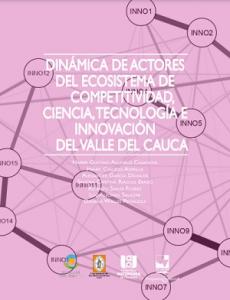Dinámica de actores del ecosistema de Competitividad, Ciencia, Tecnología e Innovación del Valle del Cauca
-
Capítulo 1. Proximidad y/o distancias que existen entre los actores del sistema de competitividad, ciencia, tecnología e innovación del Valle del Cauca a nivel social, organizacional, cognitivo, geográfico, institucional, y cultural
-
Capítulo 2. Absorción de conocimientos (aprendizaje) en el Valle del Cauca (Cali, Buenaventura y Tuluá) e identificación y eficiencia de canales de transmisión del conocimiento a nivel empresarial y académico
-
Capítulo 3. Difusión y transferencia de tecnología y conocimiento en el Valle del Cauca
Descargas
Acevedo Rodríguez, A. L., & Moreno Carvallo, D. L. (2017). Planes Estratégicos Departamentales/Regionales de Ciencia, Tecnología e Innovación (PEDCTI/PERCTI) en Colombia: un estudio comparativo entre los departamentos del Cauca y Valle del Cauca (2009–2015).
Alimohammadlou, M., & Eslamloo, F. (2016). Relationship between Total Quality Management, Knowledge Transfer and Knowledge Diffusion in the Academic Settings. Procedia - Social and Behavioral Sciences, 230, 104-111. https://doi.org/https://doi.org/10.1016/j.sbspro.2016.09.013
Arocena, R., & Sutz, J. (2000). Looking at National System of Innovation from the South. Industry & Innovation, 7, 55-75. https://doi.org/10.1080/13662710050030303
Balau, M. (2015). The Influence of Market Context on Business Strategy, Competitor Imitation and Operational Effectiveness. Acta Oeconomica, 11, 33-40.
Barroso Simao, L., Gouveia Rodrigues, R., & Madeira, M. J. (2016). External relationships in the organizational innovation. RAI Revista de Administração e Inovação, 13(3), 156-165. https://doi.org/https://doi.org/10.1016/j.rai.2016.06.002
Battistella, C., De Toni, A. F., & Pillon, R. (2016). Inter-organisational technology/knowledge transfer: a framework from critical literature review. The Journal of Technology Transfer, 41(5), 1195-1234.
Blichfeldt, H., & Faullant, R. (2021). Performance effects of digital technology adoption and product & service innovation – A process-industry perspective. Technovation, 102275. https://doi.org/https://doi.org/10.1016/j.technovation.2021.102275
Busom, I., & Vélez-Ospina, J. A. (2017). Innovation, Public Support, and Productivity in Colombia. A Cross-industry Comparison. World Development, 99, 75-94. https://doi.org/https://doi.org/10.1016/j.worlddev.2017.07.005
Cardoza, G., Fornes, G., Farber, V., Gonzalez Duarte, R., & Ruiz Gutierrez, J. (2016). Barriers and public policies affecting the international expansion of Latin American SMEs: Evidence from Brazil, Colombia, and Peru. Journal of Business Research, 69(6), 2030-2039. https://doi.org/https://doi.org/10.1016/j.jbusres.2015.10.148
Chirumalla, K. (2021). Building digitally-enabled process innovation in the process industries: A dynamic capabilities approach. Technovation, 102256. https://doi.org/https://doi.org/10.1016/j.technovation.2021.102256
Clegg, C., Unsworth, K., Epitropaki, O., & Parker, G. (2002). Implicating Trust in the Innovation Process. Journal of Occupational and Organizational Psychology, 75, 409-422. https://doi.org/10.1348/096317902321119574
Cowan, R. (2004). Network models of innovation and knowledge diffusion. https://EconPapers.repec.org/RePEc:unm:umamer:2004016
Crespi, G., & Zuniga, P. (2012). Innovation and productivity: evidence from six Latin American countries. World development, 40(2), 273-290.
Cupani, M. (2012). Análisis de Ecuaciones Estructurales: conceptos, etapas de desarrollo y un ejemplo de aplicación. 2, 186-199.
Damanpour, F. (1987). The adoption of technological, administrative, and ancillary innovations: Impact of organizational factors. Journal of management, 13(4), 675-688.
Dovey, K. (2009). The Role of Trust in Innovation. Learning Organization, The, 16, 311-325. https://doi.org/10.1108/09696470910960400
Díaz, L. V. (2007). GESTIÓN DEL CONOCIMIENTO Y DEL CAPITAL INTELECTUAL: UNA FORMA DE MIGRAR HACIA EMPRESAS INNOVADORAS, PRODUCTIVAS Y COMPETITIVAS. Revista Escuela de Administración de Negocios(61), 39-67. (IN FILE)
Elejabarrieta, F., & Iñiguez, L. (2008). Construcción de escalas de actitud, tipo Thurstone y Likert. La Sociología en sus escenarios(17).
Escobedo Portillo, M. T., Hernández Gómez, J. A., Estebané Ortega, V., & Martínez Moreno, G. (2016). Modelos de ecuaciones estructurales: Características, fases, construcción, aplicación y resultados. Ciencia & trabajo, 18, 16-22.
Evans, J. R., & Lindsay, W. M. (2002). The management and control of quality (Vol. 5). South-western Cincinnati, OH.
Ferraris, A., Giachino, C., Ciampi, F., & Couturier, J. (2021). R&D internationalization in medium-sized firms: The moderating role of knowledge management in enhancing innovation performances. Journal of Business Research, 128, 711-718. https://doi.org/https://doi.org/10.1016/j.jbusres.2019.11.003
Gay, B., & Dousset, B. (2005). Innovation and network structural dynamics: Study of the alliance network of a major sector of the biotechnology industry. Research Policy, 34(10), 1457-1475. https://doi.org/https://doi.org/10.1016/j.respol.2005.07.001
Gilsing, V., Bekkers, R., Bodas Freitas, I. M., & van der Steen, M. (2011). Differences in technology transfer between science-based and development-based industries: Transfer mechanisms and barriers. Technovation, 31(12), 638-647. https://doi.org/https://doi.org/10.1016/j.technovation.2011.06.009
Guille, A., Hacid, H., Favre, C., & Zighed, D. A. (2013). Information diffusion in online social networks: a survey. SIGMOD Rec., 42(2), 17–28. https://doi.org/10.1145/2503792.2503797
Heinzl, J., Kor, a.-l., Orange, G., & Kaufmann, H. (2012). Technology transfer model for Austrian higher education institutions. The Journal of Technology Transfer, 38. https://doi.org/10.1007/s10961-012-9258-7
Hock-Doepgen, M., Clauss, T., Kraus, S., & Cheng, C.-F. (2021). Knowledge management capabilities and organizational risk-taking for business model innovation in SMEs. Journal of Business Research, 130, 683-697. https://doi.org/https://doi.org/10.1016/j.jbusres.2019.12.001
Jabar, J., Soosay, C., & Santa, R. (2011). Organisational learning as an antecedent of technology transfer and new product development: A study of manufacturing firms in Malaysia. Journal of Manufacturing Technology Management, 22, 25-45. https://doi.org/10.1108/17410381111099798
Jaramillo, H., Lugones, G., Salazar, M., & de Ciencia, R. I. d. I. (2000). Manual de Bogotá: normalización de indicadores de innovación tecnológica en América Latina y el Caribe.
Jiafu, S., Xuefeng, Z., Jiaquan, Y., & Xiaoduo, Q. (2019). Modelling and simulating knowledge diffusion in knowledge collaboration organisations using improved cellular automata. Journal of Simulation, 13(3), 181-194. https://doi.org/10.1080/17477778.2018.1508937
Jiang, X., Jiang, F., Cai, X., & Liu, H. (2015). How does trust affect alliance performance? The mediating role of resource sharing. Industrial Marketing Management, 45, 128-138.
Kumar, P., & Sinha, A. (2021). Information diffusion modeling and analysis for socially interacting networks. Social Network Analysis and Mining, 11(1), 1-18.
Kumar, S., Saini, M., Goel, M., & Panda, B. S. (2021). Modeling information diffusion in online social networks using a modified forest-fire model. Journal of intelligent information systems, 56(2), 355-377.
Lara, A. (2014). Introducción a las ecuaciones estructurales en AMOS y R. Universidad de Granada. Disponible en: http://masteres. ugr. es/moea/pages/curso201314/tfm1314/tfm-septiembre1314/memoriamasterantonio_ lara_hormigo/. Consultado, 19(02), 2018.
Leonidou, E., Christofi, M., Vrontis, D., & Thrassou, A. (2020). An integrative framework of stakeholder engagement for innovation management and entrepreneurship development. Journal of Business Research, 119, 245-258. https://doi.org/https://doi.org/10.1016/j.jbusres.2018.11.054
Li, M., Wang, X., Gao, K., & Zhang, S. (2017). A survey on information diffusion in online social networks: Models and methods. Information, 8(4), 118.
Liao, S.-H., & Wu, C.-c. (2010). System perspective of knowledge management, organizational learning, and organizational innovation. Expert Systems with Applications, 37(2), 1096-1103. https://doi.org/https://doi.org/10.1016/j.eswa.2009.06.109
Mao, C., Yu, X., Zhou, Q., Harms, R., & Fang, G. (2020). Knowledge growth in university-industry innovation networks–Results from a simulation study. Technological forecasting and social change, 151, 119746.
Mardani, A., Nikoosokhan, S., Moradi, M., & Doustar, M. (2018). The Relationship Between Knowledge Management and Innovation Performance. The Journal of High Technology Management Research, 29(1), 12-26. https://doi.org/https://doi.org/10.1016/j.hitech.2018.04.002
Molina Arias, M. (2017). ¿Qué significa realmente el valor de p? Pediatría Atención Primaria, 19, 377-381.
Mousavi, S., Bossink, B., & van Vliet, M. (2018). Dynamic capabilities and organizational routines for managing innovation towards sustainability. Journal of Cleaner Production, 203, 224-239. https://doi.org/https://doi.org/10.1016/j.jclepro.2018.08.215
Mundra, N., & Mishra, R. P. (2021). Business Sustainability in Post COVID-19 Era by Integrated LSS-AM Model in Manufacturing: A Structural Equation Modeling. Procedia CIRP, 98, 535-540.
Ode, E., & Ayavoo, R. (2020). The mediating role of knowledge application in the relationship between knowledge management practices and firm innovation. Journal of Innovation & Knowledge, 5(3), 210-218.
Oviedo, H. C., & Campo-Arias, A. (2005). Aproximación al uso del coeficiente alfa de Cronbach. Revista Colombiana de Psiquiatría, 34, 572-580.
Ošenieks, J., & Babauska, S. (2014). The Relevance of Innovation Management as Prerequisite for Durable Existence of Small and Medium Enterprises. Procedia - Social and Behavioral Sciences, 110, 82-92. https://doi.org/https://doi.org/10.1016/j.sbspro.2013.12.850
Panetti, E., Parmentola, A., Ferretti, M., & Reynolds, E. B. (2019). Exploring the relational dimension in a smart innovation ecosystem: a comprehensive framework to define the network structure and the network portfolio. The Journal of Technology Transfer, 1-22.
Pawłyszyn, I., Fertsch, M., Stachowiak, A., Pawłowski, G., & Oleśków-Szłapka, J. (2020). The Model of Diffusion of Knowledge on Industry 4.0 in Marshallian Clusters. Sustainability, 12(9), 3815.
Porter, M. E. (1985). Competitive advantage: Creating and sustaining superior performance. New York: FreePress.
Qureshi, S. (2015). Are we making a better world with information and communication technology for development (ICT4D) research? Findings from the field and theory building. In: Taylor & Francis.
Russell, R. S., & Taylor-Iii, B. W. (2008). Operations management along the supply chain. John Wiley & Sons.
Santa Florez, R. A., Tegethoff, T. M., Morante, D., Milena Pico, S., Cardona Gaona, D., Messu, D. C., . . . Fajardo Ortiz, M. (2020). Regiones inteligentes. El factor humano.
Santa, R., Ferrer, M., Bretherton, P., & Hyland, P. (2009). The necessary alignment between technology innovation effectiveness and operational effectiveness. Journal of Management and Organization, 15(2), 155.
Santa, R., Hyland, P., & Ferrer, M. (2014). Technological innovation and operational effectiveness: Their role in achieving performance improvements. Production Planning and Control, 25. https://doi.org/10.1080/09537287.2013.785613
Santa, R., MacDonald, J. B., & Ferrer, M. (2019). The role of trust in e-Government effectiveness, operational effectiveness and user satisfaction: Lessons from Saudi Arabia in e-G2B. Government Information Quarterly, 36(1), 39-50.
Santa, R., Morante, D., & Tegethoff, T. (2019). Regiones inteligentes. La competitividad en el Valle del Cauca. Santiago de Cali: Editorial ICESI y Escuela Militar de Aviación “Marco Fidel Suárez”(EMAVI).
Thomas, B., Packham, G., & Miller, C. (2001). A temporal model of technology diffusion into small firms in Wales. Industry and Higher Education, 15(4), 279-288.
Tidd, J., & Pavitt, K. (2011). Managing Innovation: Integrating Technological, Market And Organizational Change.
Valdez Juárez, L. E., García Pérez de Lema, D., & Maldonado Guzmán, G. (2017). TIC y la gestión del conocimiento como elementos determinantes del crecimiento de la PyME. Investigación y Ciencia, 25(70), 50-62. (IN FILE)
Zhao, J., Wu, G., Xi, X., Na, Q., & Liu, W. (2018). How collaborative innovation system in a knowledge-intensive competitive alliance evolves? An empirical study on China, Korea and Germany. Technological Forecasting and Social Change, Elsevier, 137(C), 128-146. https://doi.org/DOI: 10.1016/j.techfore.2018.07.001


Esta obra está bajo una licencia internacional Creative Commons Atribución-CompartirIgual 4.0.



